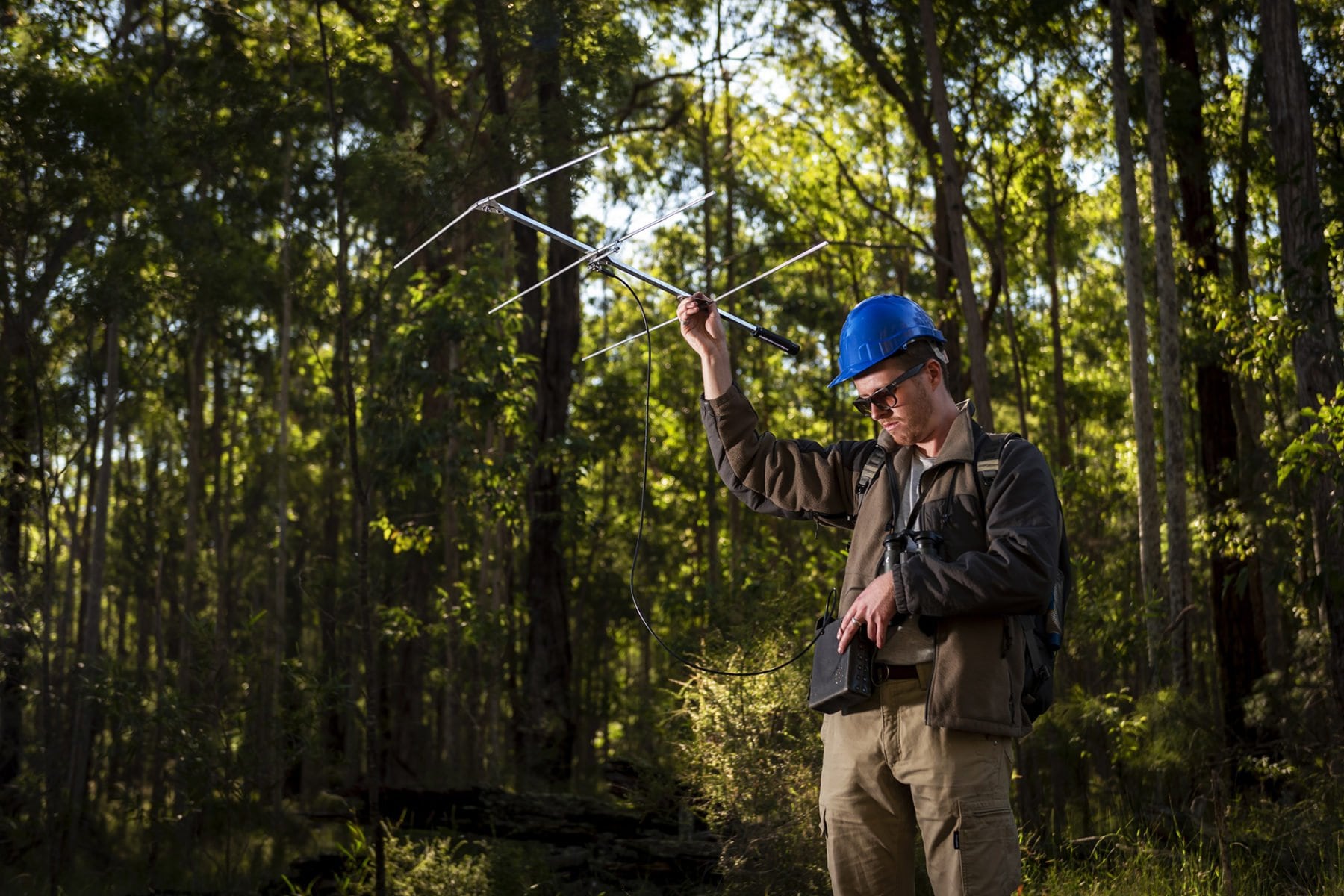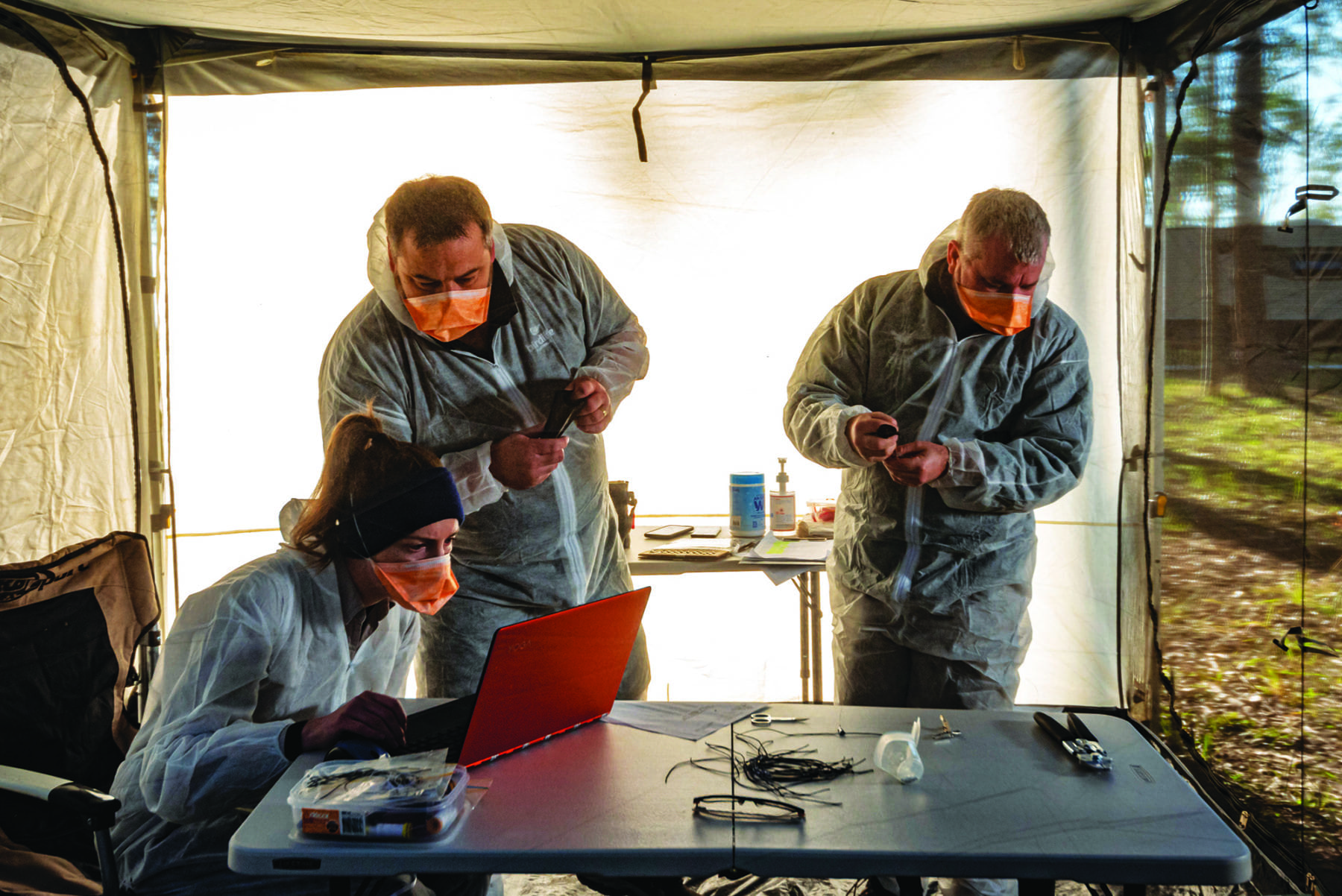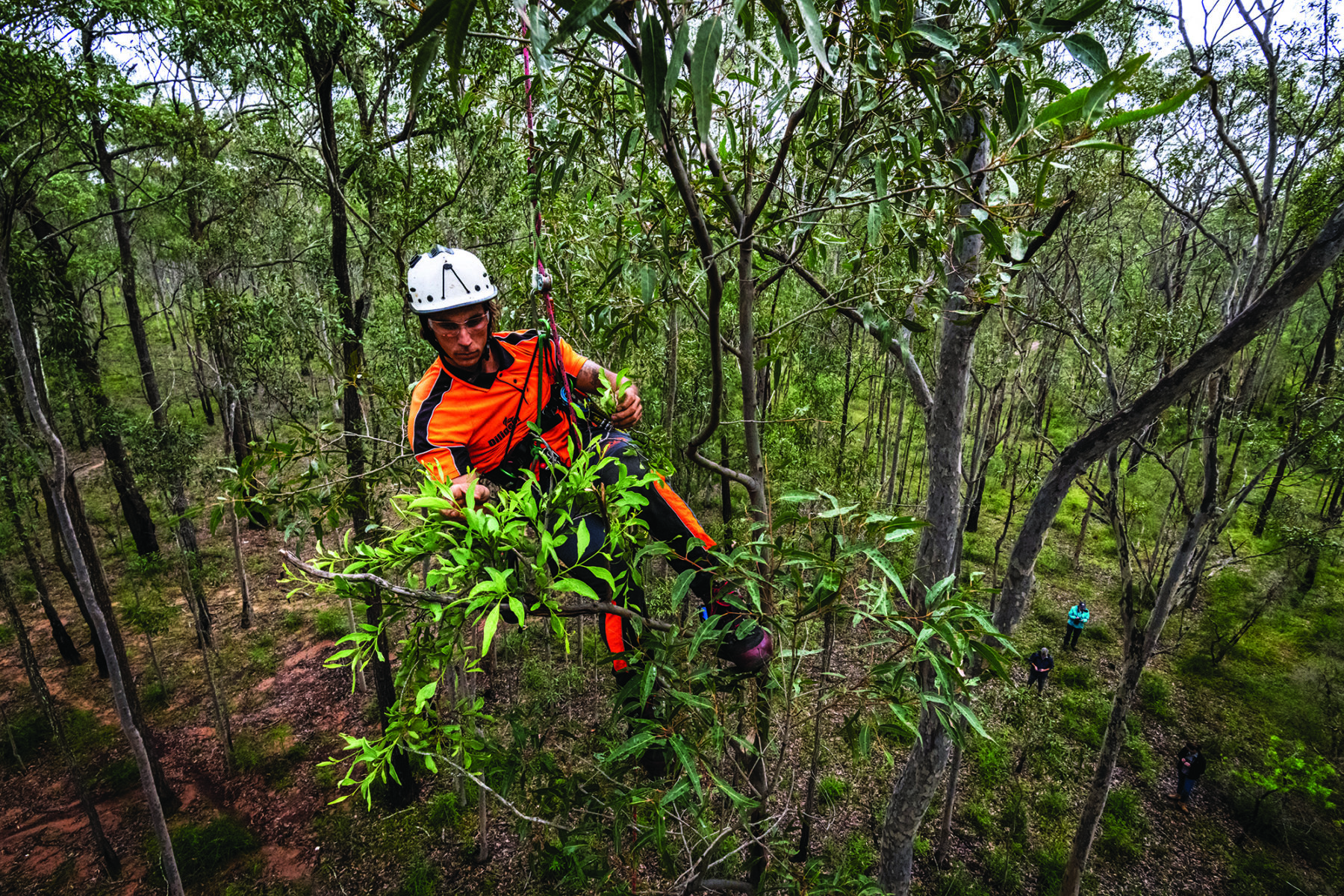IT’S JUST AFTER lunchtime, the morning rains have finally cleared and the sun begins breaking through the clouds. Max Breckenridge, a captive release project officer with BirdLife Australia (BLA) is slowly walking along a dirt road that cuts through a patch of untouched spotted gum–ironbark forest in the Lower Hunter Valley in New South Wales.
One hand holds an antenna above his head, the other rests on a radio receiver sitting around his waist. Suddenly he stops, mid-step, and slowly pivots to the left. “I’ve got a signal for bird blue-blue,” he says, adjusting the gain on his radio receiver.
Dean Ingwersen, BLA’s Woodland Bird Program (WBP) leader and regent honeyeater recovery coordinator, raises his binoculars, looks into the canopy and responds. “Yes, that’s definitely blue-blue,” he confirms. “I can see the blue-blue bands on her leg.”
Three days ago, this bird was located 150km away at Taronga Zoo, in Sydney, having been born there in a crucial captive breeding component of a long-term national plan to rescue this struggling species. And just a few hours earlier, blue-blue had been perched with 19 other regent honeyeaters in one of four release tents tucked away in bushland on a private property less than a kilometre away.
Exact historical numbers are hard to determine, but the regent honeyeater was once said to be common, with early accounts describing its numbers as “great” and “immense”. In fact, in the early 1900s regents were sometimes the most common honeyeater in parts of the species’ range and, up until the 1960s, were even regular visitors to some Melbourne suburbs.
Without much searching, they could be found all the way up Australia’s east coast in a band within about 300km of the coast, from Adelaide to Rockhampton in Queensland, thriving in habitats such as box–ironbark open forests and woodland areas that contain key food and nesting resources.
Now they are extinct in South Australia and rare in Victoria and Queensland, where their distribution has contracted severely and is patchy.
With total numbers plummeting in the last couple of decades to fewer than 350, the regent is now one of Australia’s most endangered birds, its conservation status of critically endangered seeing it hover just above the extinct in the wild category. So there’s a lot riding on blue-blue and the other birds released with her here today.

Critically endangered
It’s no surprise the regent is now critically endangered, says Mick Roderick, the WBP manager.
“Continued habitat destruction from residential, industrial and agricultural projects now means that less than 15 per cent of the regent honeyeater’s original foraging and breeding habitat remains,” he explains. “And of those areas, much exists as fragmented remnants in poor condition, missing important basic ecological features like understorey and high-quality nectar-producing trees.
“Add to this the impacts of climate change – from increased droughts and bushfires, to altered flowering patterns – and this all results in further habitat degradation and changes to nectar and nest-site availability.”
Of course habitat destruction and climate change affect many species. But, as regent numbers have fallen, there’s been a compounding effect that’s helped quicken the species’ decline. The size of aggregations that historic rec-ords tell us once occurred played an important ecological role for regents. Big flocks would have given them a strength-in-numbers advantage to effectively compete with larger, more aggressive, honeyeaters for nectar food resources.
Now the regent simply doesn’t have the numbers to mount a defence. As a result, the bigger native honeyeaters, particularly noisy miners, have taken a foothold in traditional regent territories.
“We have created the perfect environment for adaptive species like the noisy miner to flourish and this has been to the detriment of rich patch specialists like the regent honeyeater,” Mick explains.
“Noisy miners love fragmented landscapes, [which is why] they do well in urban environments. But regent honeyeaters need large patches of [undisturbed] wooded areas on fertile soils and along rivers. So by leaving only small and fragmented habitat pockets for the regent honeyeater, the now-burgeoning numbers of noisy miners come in and drive them out. Noisy miners are just unrelenting. They will do anything to keep regent honeyeaters out of their territory, chasing adult birds incessantly and even pulling nests apart.”
Add to this the inherent dangers that threaten a species for which numbers have fallen to a critically low level – such as bushfires or disease, which can wipe out a large percentage of a surviving population to reduce genetic diversity – and it’s easy to understand why the regent is now at great risk of extinction. And it’s because of this that we are now here in this secret Hunter Valley location.
This release is part of one important strategy to rescue the species, using captive breeding to bolster the wild population until it can become self-sustaining again.
Other work underway includes improving the extent and quality of suitable habitat and continuing field research to better understand what’s happening to wild populations and which conservation interventions are working.

Large-scale NSW release
The first release of captive-bred regents was in 2000 when a small number bred at Taronga Zoo were released in Capertee Valley, a traditional stronghold for the species north of Lithgow on the Blue Mountains’ western edge, in NSW. Taronga and BLA have coordinated five other releases in north-eastern Victoria, successfully putting almost 300 captive-bred birds into the wild. The captive breeding program involves a range of institutions across eastern Australia, coordinated by Taronga Zoo.
This, the first large-scale NSW release, is significant; the birds are being released into an area where a handful were captured eight years ago for breeding in this program. More significant, however, is the ecological importance of the area to the species’ survival.
Nearby, within the Lower Hunter Valley, are the Tomalpin Woodlands, a largely unfragmented expanse of spotted gum–ironbark forest – perfect regent habitat. Being such intact forest means it supports virtually no noisy miners or they are in such small numbers they can easily be managed.
Also, here the eucalypt diversity, which includes the spotted gum and broad-leaved ironbark, means flowering is almost continuous with different species blooming sequentially. This makes it one of few places able to support regents nearly all year-round. However, some of this important area is under threat.
In 2002, in a plan to expand local industry and employment opportunities, a significant part of the Tomalpin Woodlands was rezoned for industrial development by the local council as part of what’s now called the Hunter Economic Zone. Bitumen roads were carved through pristine habitat in preparation for businesses to move in. To date only one has and the project has stalled. However, what development has managed to proceed so far has facilitated easy access to the area leading to damaging environmental consequences.
Four-wheel-driving, cross-country motorbiking and rubbish dumping, along with vandalism, have begun to scar the area. While we’re here for this release of regents into largely undisturbed habitat, we can hear the not-too-distant sound of chainsaws cutting down ironbark trees for firewood.
Early one morning we came across a smouldering boat that had been dragged into the area, seemingly by vandals, and set alight the night before.
About 50 per cent of the Tomalpin Woodlands is in the hands of private developers. Fortunately, however, most of the remaining area is owned by the Mindaribba Local Aboriginal Land Council, which recognises its importance as country for local Aboriginal people and a vital place for protection of endangered flora and fauna, including the swift parrot as well as the regent honeyeater.
“Ironically, we now have this important environmental site because of its coalmining history,” explains the land council’s CEO, Tara Dever. “When coalmining started here more than 100 years ago, it was not open-cut but underground and this meant the impact was a lot gentler on the surface. Also, because the operation needed an easy and continuous supply of local trees to shore up the mines, it meant many ancient trees – ‘grandmother trees’ – were left untouched to help re-seed and regenerate the area.
“Most importantly, this land use protected the area from the historical raping and pillaging style farming of that era, meaning people didn’t come in and strip clear the land.”

Keeping the regent honeyeater off Australia’s growing extinction list
Preparing for a release of captive-bred regents takes a lot of planning and preparation. It requires a multi-disciplinary approach that involves behavioural biologists, ecologists and arborists as well as Taronga keepers and veterinary staff. It’s particularly important the birds are equipped with the skills for survival in the wild.
Regents need, for example, to experience nest-making. In the wild, nests are made from leaves, grass and animal hair, stuck together with spider webs. Getting the honeyeaters used to this in captivity isn’t easy. It turns out that regents are choosy about both the type and condition of spider web.
“Regent honeyeaters clearly prefer web from the black house spider, and it really needs to be fresh,” explains Michael Shiels, supervisor for Taronga Zoo’s Australian Fauna Birds section. “If they’re a bit old or dusty, they just don’t use them.”
Usually, preparation for a release would take about six months while a site is assessed to ensure it can provide adequate food. But this year the Lower Hunter Valley suddenly produced ideal conditions and within just six weeks BLA and Taronga Zoo staff, in collaboration with the NSW Department of Planning, Industry and Environment, planned the release.
Once everything was ready, the birds were brought to the location two days before to allow them to acclimatise to local conditions. They were weighed, measured and given a final health check. For those big enough, such as bird blue-blue, radio transmitters were attached to trace their movements, which provides vital information that informs future releases and contributes to the knowledge of the species in the wild.
Then, during a two-day period, 20 regent honeyeaters were released – 11 females and nine males – 13 fitted with transmitters. Significantly a flock of 13 wild regents was present at the site at the time of release. This in itself was noteworthy because it was the largest flock found anywhere since winter 2017, at the very site of the release. It’s hoped these wild birds will breed with the captive-bred birds.
Rescuing regent honeyeater habitat also benefits other threatened species, both directly and indirectly. The type of box–ironbark forest favoured by regents supports other nat-ive nectar-dependent species, from bees to flying-foxes.
Regent honeyeaters are also major pollinators, helping maintain healthy forests as vital habitat for many other native animals, including the swift parrot, hooded robin, painted honeyeater, squirrel glider and brush-tailed phascogale.
I ask Dean Ingwersen what one thing he’d suggest we all do to help ensure the regent honeyeater is kept off Australia’s growing extinction list. “It can’t be just one thing,” he replies passionately. “If we successfully breed and release these beautiful birds into an environment with limited, poor-quality and fragmented habitat, they just won’t do well. And if we only focus on protecting the habitat that’s left, and wait 30 years or so for other trees we are now planting to grow, we’ll probably be out of time.
“Of course, if we don’t continually study them to know exactly what’s happening, what’s working and what isn’t, we may not be as effective as we need to be. So there isn’t just one thing. Having driven them to the brink of extinction, we need to work on multiple strategies, over multiple time frames.”
It’s clear that protecting and enhancing remaining intact habitat, removing noisy miners from breeding sites and adding captive-bred birds into the population are all vital. But only time will tell if it’s enough. For now, I know I’m very lucky to be one of few people to have been able to get close to these magnificent birds. But I’d be a lot happier to know it wasn’t such a rare privilege.


